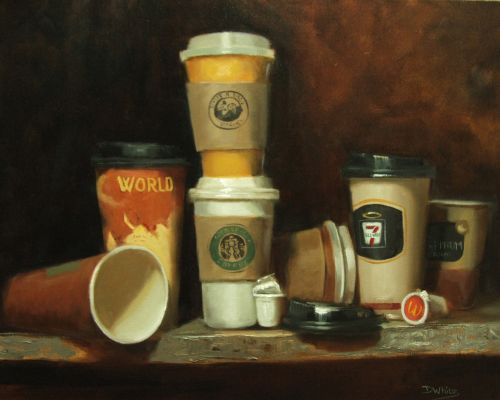All About Coffee

Coffee on the move, whether in a car or during a stroll down the street to a park bench, is always an experience. Most establishments have converted to foam cups, but there are still a few holdouts that sell coffee in cardboard cups, with and without the little elephant ear handles. In the wake of the “hot lap” incident most cardboard cups have a printed warning, “Caution, cup can be hot.” However, once you pick up the cup to read the warning, it’s either untrue or old news, unless, of course, you have one of those little corrugated sleeves that have proven beyond any doubt that Americans will pay outrageously high prices for anything.
The foam cups are surprisingly leak-proof, considering that they are made by pressing little foam balls together until they stick. They do leak occasionally, especially if used for more than a week without periodic drying out sessions. I had one that leaked badly, but I found a sheet metal screw in the bottom of the cup holder in my truck that poked a new hole in the cup each time I set it in the holder. It was like trying to drink out of a colander, but you really can’t blame the cup.
Just about anything would develop a leak after being repeatedly impaled upon a sharply pointed sheet metal screw. “To go” cups usually come with a plastic lid and if you keep the lid on, the foam cups do a very good job of keeping the coffee hot. This type of plastic must have been developed only for this purpose. Have you ever seen anything else made out of this material? There are three basic designs for these lids, all of which are nearly impossible to remove without spilling the coffee. The most common type has a pie-shaped section that you tear out of the rim and fold back. Usually there is a clever little latch to hold it out of the way. This design presents a nice smooth surface to the lower lip, but the loss of structural integrity in the rim leads to leaking unless you have a mouth the size of a two-quart pail.
The second type has a hole in the lid shaped like a fat teardrop similar to the pop-top on an aluminum can. This design has less leakage, because the rim is intact, but has a much less comfortable presentation to the mouth. The last design also leaves the rim intact, but requires some lip dexterity. Pressing down on various different types of flap with your top lip provides access to the coffee. It works well unless you happen to be a person who is “bottom-lipped” instead of “top-lipped”, and cannot operate the flap. Lippedness has nothing to do with handedness, and the overwhelming majority of people surveyed were top-lipped.
The coffee itself varies widely. One chain advertises “The freshest coffee going,” but based on my experience they all follow the same routine. When the pot is nearly empty they pour it together with another partial pot. When it steeps and simmers long enough, they put a “Gourmet” label on it. Since these stores are open 24×7, conceivably, you could be drinking coffee brewed during the Kennedy administration. Consumers are to blame for this. No one is willing to take that last cup because a) they are afraid they will have to make a pot or b) the last cup can’t possibly be fresh. The store doesn’t want to pour it out because that last cup is pure profit. They made up the cost of the coffee on the first two cups.
Most establishments use approximately 1.25 ounces of coffee to brew a standard pot (supposedly ten cups). Since those “cups” are pretty small, let’s assume five cups at $1.09 each, (in your own cup), or $5.45. One pound of coffee will make 12.8 pots, so the store takes in $68.76. Therefore, you pay almost $69 a pound just to have somebody mix it with hot water. Then you are allowed to buy it, burn your mouth, and spill it down the front of your shirt or someplace else that’s a little more sensitive.

